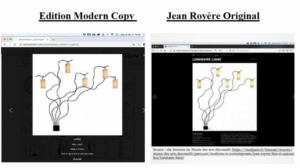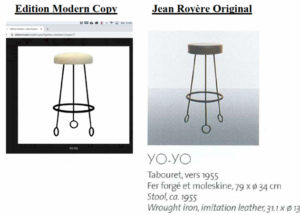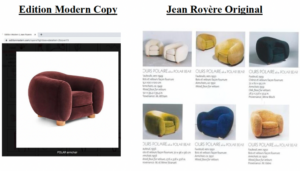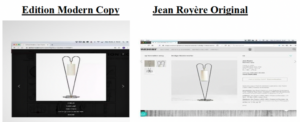Clarifying Copyright Protection for Useful Works
Earlier this month, the Central District of California granted summary judgment finding copyright infringement of eight furniture designs in Jean Royère Sas, et al. v. Edition Modern, et al. This decision provides further clarification for artists and the copyrightability of their work embodied into functional objects.
Since the landmark decision Star Athletica in 2017, the U.S. Copyright Office maintains significant scrutiny on copyright applications that involve useful objects[1]. Applicants have experienced inconsistent responses from the U.S. Copyright Office, regardless as to whether their designs are used on sneakers, lamps, decanters, or whiskey glasses.
In or around 2015, Edition Modern, a furniture store, began selling furniture pieces it expressed were “in the style of” the modern French designer Jean Royère. As such, the Plaintiffs, Jean Royère SAS, and Jelena Markovic, filed a lawsuit and moved for partial summary judgment for copyright infringement against Edition Modern based on its unpermitted copying of eight furniture designs belonging to Jean Royère (collectively, the “Furniture Designs”).
A few examples of these Furniture Designs are featured below:




Although plaintiffs are generally required to have a copyright registration from the U.S. Copyright Office to bring a lawsuit regarding the subject works, these Furniture Designs were exempt from this requirement because they were created outside the United States. Therefore, the U.S. Copyright Office was not involved in weighing in on the copyrightability of these designs.
That said, the Court restated the separability test introduced under Star Athletica: “[t]he ultimate separability question [] is whether the feature for which copyright protection is claimed would have been eligible for copyright protection as a pictorial, graphic, or sculptural work had it originally been fixed in some tangible medium other than a useful article before being applied to a useful article.” Here, the Court considered:
- “[t]he soft, bulbous shapes of the Ours Polaire sofa, Ours Polaire armchair, and Sculpture armchair, the vine like elements of the Liane wall light: the heart and flower shapes of the Coeur floor lamp, the egg-like shape of the Oeuf chair; the rings of the Yo-Yo stool; and the upward cup shapes of the Élphanteau chair, are all readily separately identifiable;”
- “[i]f the sculptural features of each Work were used in another non-utilitarian medium – if, for example, the Ours Polaire sofa were made of fine glass such that one could not sit on it – they could nonetheless exist as sculptural works of art;” and
- many of the original works had been displayed in art museums.
This decision comes in the wake of many application refusals by the U.S. Copyright Office which often conclude that the separable components of the useful article are common symbols or shapes and not original enough.[2] Following this decision, the Copyright Office will need to be more discerning as to the types and presentations of shapes in each work.
Speak with an IP Lawyer at GS2Law in confidence. If you would like to know more about copyright protection and enforcement, we encourage you to get in touch. To schedule a confidential consultation with an IP lawyer at GS2 Law, please request an appointment online today.
[1] For an explanation of the Copyright Act’s treatment of useful articles, please see our previous Insight, entitled “Stepping into the Metaverse: How NFTs May Present a Loophole for Fashion Copyright Protection.” August 29, 2022.
[2] “In all cases, a visual art work must contain a sufficient amount of creative expression. Merely bringing together only a few standard forms or shapes with minor linear or spatial variations does not satisfy this requirement.” U.S. Copyright Office, Compendium of U.S. Copyright Office Practice §101 (3d ed. 2021).
